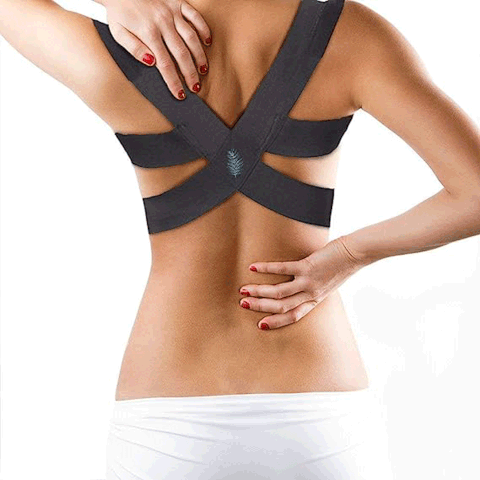Do Posture Correctors Work? We Asked Spine Experts
Slouchers, take note.

PeopleImages/Getty Images
How do posture correctors work? These wearable devices, which can look like a harness, a corset, or a full shirt, gently pull our shoulders, back, and neck into position, claiming to be able to train us until good posture becomes second nature. They promise to lift us out of our slump—but do posture correctors deliver on their promises? We asked experts to set the record straight.
Meet the Expert
Theresa Marko, PT, DPT, MS, OCS, is a licensed physical therapist, board-certified orthopedic clinical specialist, and owner of Marko Physical Therapy in New York City.
Rahul Shah, MD, is a board-certified orthopedic surgeon in Vineland, New Jersey.
Tara Jo Manal, PT, DPT, is a physical therapist and senior vice president of scientific affairs for the American Physical Therapy Association.
Why Is Good Posture Important?
Good posture is like a superpower. It can increase our energy, reduce strain on our muscles and joints, improve our digestion, boost our mood, and make us look more commanding and statuesque. Essentially, good posture allows our systems—nervous, circulatory, respiratory, and so on—to function correctly.
There is a risk of developing pain related to slouching, and good posture can prevent the development of that pain. When you are upright, either sitting or standing, your body has muscles that should be activated and muscles that should be relaxed. Slouching mixes up those muscles, which can be painful.
As you get older, falling becomes more of a risk and a problem. Good posture equals good balance, which reduces fall risk and injuries that might be sustained related to a fall.
But chronic slouching is a hard habit to break, as you know if you constantly catch yourself hunching over your laptop like a teddy bear that's losing its stuffing.
What Posture Correctors Can Do
Posture correctors reposition us into sitting and standing the way Mother Nature intended: shoulders pulled back and aligned with the spine, chest open.
“It increases your awareness of the way you want to hold yourself, which provides feedback to your body and brain,” says Theresa Marko, licensed physical therapist and board-certified orthopedic clinical specialist. “Your joints become accustomed and your muscles learn to fire in that position.”
When we repeatedly activate those muscles in our new upright stance (so the idea goes), eventually muscle memory kicks in, turning our lumpen teddy bear into a gracefully erect swan.
Related: 5 Simple Exercises Than Can Help Improve Your Posture—No Equipment Needed
What Posture Correctors Can't Do
That said, a posture corrector is not a shortcut or magic bullet. “You don’t want to rely on a device or brace to do the work for you,” Marko says, “but rather train your muscles to give you the support you need by building up your strength.” The irony is that constantly wearing a corrector may encourage your muscles to slack off, leaving you even weaker and more slouch-prone.
You Don't Need to Wear It All Day, Every Day
It’s fine to try a corrector if you need a posture refresher course, but wear it sparingly, says Rahul Shah, a board-certified orthopedic surgeon: “When patients ask whether they can use them, I advise no more than an hour a day.” Think of a posture corrector like a personal trainer: She can show you proper form, but she can’t do the reps for you.
A Posture Corrector Won’t Necessarily Relieve Your Back Pain Problems
If you’re having back pain and hope better posture will alleviate it, you’ll probably be disappointed, says Tara Jo Manal, physical therapist and senior vice president of scientific affairs for the American Physical Therapy Association.
“There’s no good evidence that poor posture leads to pain,” Manal says. “Many studies have sought to link the two and failed to do so.” If your back hurts, you'd be better off seeing a doctor or physical therapist rather than buying and wearing a posture corrector to fix your issues. “A physical therapist can help identify limitations in your strength or flexibility that could be contributing to your problem, and offer ergonomic advice if you’re deskbound, ” Manal says.
What to Look For in a Posture Corrector
It depends on the amount of support you want (just a shoulder brace or full back coverage?) and what’s comfortable for your body. While you want a snug fit, you should still be able to move freely. “Correctors are not immobilizers,” Manal says. “If they’re tight or rigid, they won’t allow your muscles to strengthen and could cause other unintended problems.”
A few popular options, if you're considering a posture corrector:
Berlin and Daughter Posture Corrector

amazon.com
Soft and flexible, this one slips over the shoulders like a backpack and is sleek enough to fit under clothes (if that’s what you prefer). Available in six sizes (XS–XL).
Hempvana Arrow Posture Corrector

Made of lightweight, flexible hemp fiber, this one easily goes over the shoulders and fastens around the waist, and the straps are fully adjustable. Available in two sizes (S/M and M/L).
Upright GO 2 Smart Posture Corrector

This high-tech option uses built-in sensors to monitor your posture throughout the day and syncs with an accompanying app to report on your progress. Put it in training mode and it will gently vibrate whenever you start to slouch, the way your mom used to poke you at the dinner table.
Other Ways to Improve Your Posture
Practice good posture without the brace. “Think of stones in a stack,” Dr. Shah says. “Your ankles, your pelvis, your lower back, your chest and shoulders, then your head—each is a stone stacked on the one beneath it.” He also recommends stretching and strengthening exercises like yoga and Pilates that open up the pelvis, shoulders, and upper back. Although standing nice and tall may feel weird at first, he says, “as you do more exercises and get stronger, your body is going to adapt. Eventually you’ll find it’s uncomfortable to assume bad posture.”
Related: You Can Do These 7 Easy Yoga Poses Without Leaving Your Chair
For more Real Simple news, make sure to sign up for our newsletter!
Read the original article on Real Simple.

